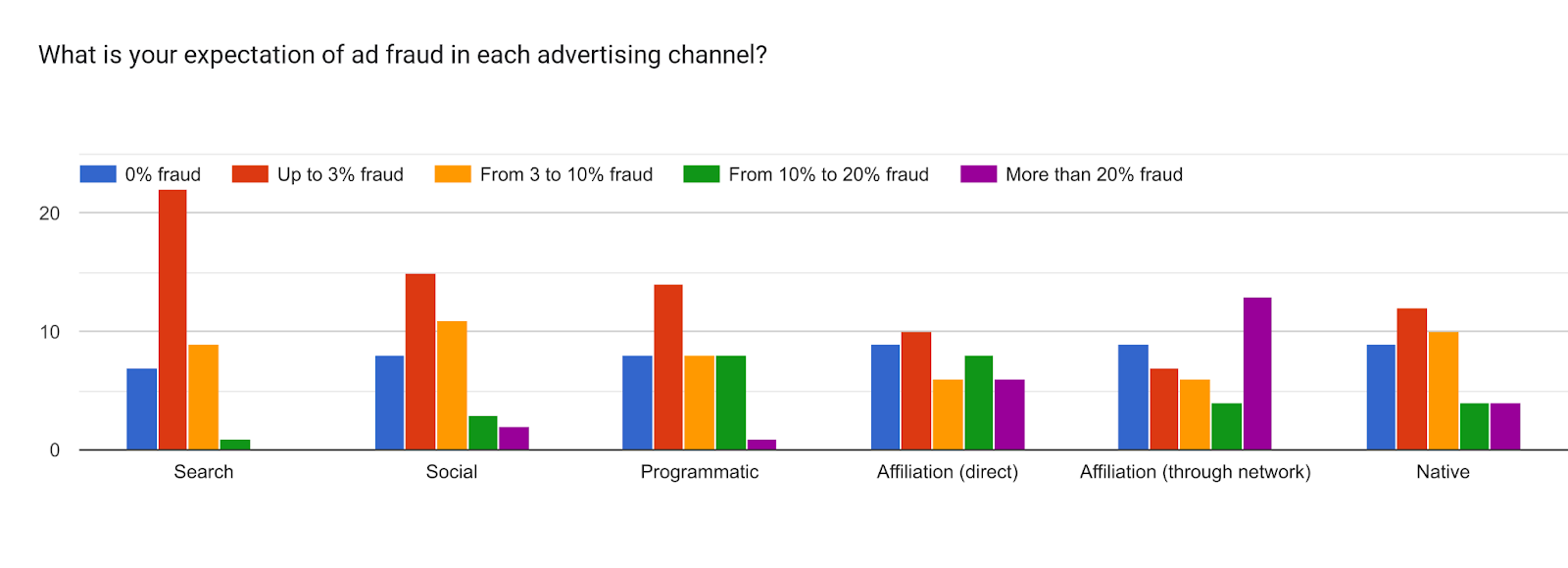Ever wondered if your chosen advertising channels are as effective as they seem?
According to our latest advertising trends survey, marketers are prioritizing audience-relevant channels. Yet, based on our 2023 Ad Fraud Report findings, marketers are also in the dark about the true scale of ad fraud rates within these channels. In this article, we provide clarity once and for all by sorting fact from fiction when it comes to ad fraud rates.
- Ad fraud rates across channels: What the data tells us
- Ad fraud rates across channels: What marketers think
- Factors influencing ad fraud rates
- The impact of high ad fraud rates on advertisers
- How to reduce ad fraud rates
Ad fraud rates across different channels: What the data tells us
Our data paints a vivid picture: While fraudsters target and exploit the entire marketing funnel, ranging from native to programmatic advertising, certain channels face notably escalated rates of invalid traffic.

Source: Ad Fraud Report 2023.
Ad fraud impacts affiliate marketing the most, with a colossal 14.3% invalid traffic
This high rate of ad fraud stems from fraudsters’ repeatedly clicking on ads (whether they use manual methods or more advanced automation software) to maximize profits from publishers and advertising networks.
Programmatic advertising is close behind with a 12.2% ad fraud rate
Programmatic advertising is a prime focus for fraudsters since they’re able to effectively conceal large volumes of ad fraud. This can be attributed to the extensive automation of the purchasing process, which can’t be monitored by humans in real time.
Native advertising, SEM, and paid social channels are also highly vulnerable
Native advertising experiences a 2.6% ad fraud rate, in large part due to fraudsters employing techniques such as domain spoofing, iFrames, and ad stacking.
SEM and social channels saw ad fraud rates of 4.4% and 2% respectively. As the most popular channels for digital advertising, this has a significant impact on ROAS and CAC.
Plus, since platforms like Facebook, Twitter, Instagram, and TikTok have become integral to modern advertising strategies (as demonstrated in our advertising trends report), this level is alarming.
TikTok is by far the channel most affected by invalid traffic, with a rate of 21.1%. This is highly relevant since the platform is expected to represent 3.1% of total digital ad spending in 2023 alone. Our team has also previously detected huge volumes of TikTok click fraud, with fraudsters using smartphone emulators to obtain fake views and clicks.
Ad fraud rates across different channels: What marketers think
According to our survey, advertisers believe that affiliate, native, and programmatic channels are most prone to ad fraud.
This is accurate for affiliate and programmatic advertising, where fraud rates are notably high. But, according to our data, native advertising actually has one of the lowest rates.

Source: 2022 Ad Fraud Trends Report: Summary of Key Findings for Advertisers.
Interestingly, some respondents believe that ad fraud poses no threat to any channel. Yet, even the seemingly “safest” channels are exhibiting ad fraud rates exceeding 2%.
While this may not sound like a large portion, consider the fact that almost 6 out of 10 respondents invest more than €50,000 per month on ads. This translates to an annual loss of €12,000 due to ad fraud.
Although ad fraud affects businesses of all types, nearly 7 out of 10 advertisers also claim they haven’t experienced ad fraud recently. However, this belief may not match reality as many respondents admit that they lack the tools or solutions needed to detect the presence of ad fraud throughout their campaigns.
Factors influencing ad fraud rates
Advertising channels
Social media channels are hotbeds for fraudulent activity. Although TikTok has the highest rate of invalid traffic (21.1%), LinkedIn comes a close second with 16.2%.
Twitter, Instagram, and Facebook saw lower rates of invalid traffic (3.3%, 6.9%, and 1.7% respectively). Yet, these figures hold weight since they rank among the top choices for digital advertising on social media platforms.
Industry
No industry is immune to ad fraud, but those heavily dependent on digital advertising are lucrative targets for fraudsters seeking maximum impact.
- The highest ad fraud rates occurred in the telecom (41%), software (35%), and banking and insurance (28%) industries. These industries are susceptible to the use of sophisticated bots generating traffic at scale, geo-masking techniques, impersonation by malware, and click and lead fraud.
- The lowest rates are experienced by the travel (2%), e-commerce (3%), and education (6%) sectors.
Geography
Ad fraud knows no borders, and with the surge in global ad spending, fraudsters continue to follow the ad fraud money flow.
- The countries with the highest rates of ad fraud across the world include India, the USA, and Nigeria.
- Across Europe, Spain, Russia, and Ukraine experience the highest levels of ad fraud.
The impact of high ad fraud rates on advertisers
Financial losses
Fraudulent clicks and views don’t result in genuine user engagement or conversions. High ad fraud rates result in advertisers wasting their typically large budgets by paying for interactions that have no chance of generating income or positive business outcomes.
Inaccurate performance metrics
Ad success hinges on click-through rates (CTR), conversion rates, and return on investment (ROI). Yet, ad fraud distorts these metrics, making it difficult for advertisers to accurately measure campaign impact and make informed business decisions.
Reduced campaign effectiveness
By diverting traffic away from genuine potential customers, ad fraud significantly undermines campaign effectiveness and hinders the chances of advertisers reaching their target audiences and achieving their campaign objectives.
Plus, when ads don’t reach genuine users, advertisers will find it more difficult to expand their customer base and drive business growth
How to reduce ad fraud rates effectively and efficiently
There’s no escaping the facts: High ad fraud rates have a huge impact on advertisers and marketers.
Maximizing advertising budgets calls for advertisers to apply methods that can effectively keep ad fraud out of their campaigns.
While manual methods like IP blocking or blacklisting can combat some instances of ad fraud, these approaches are outdated and fall short of providing the robust prevention advertisers need to carry out effective campaigns.
Leading ad fraud prevention solution Opticks is a cross-channel and full-funnel anti-ad fraud solution that detects and prevents ad fraud before it has the chance to decimate campaigns. Advertisers are ensured genuine engagement and conversions from their target audience.
To learn more about how the expert team at Opticks can improve your campaign performance by eliminating ad fraud, contact us or start your free trial.
